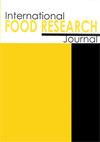Sucrose reduction and addition of agave syrup and inulin in gummies with strawberry and blackberry pulp: Impact on physicochemical, antioxidant, and sensory characteristics
IF 1
4区 农林科学
Q4 FOOD SCIENCE & TECHNOLOGY
引用次数: 0
Abstract
The current trend in the food industry involves the search for new formulations and processes to produce processed foods with enhanced nutritional value and improved functional properties that promote consumer health. Therefore, the present work aimed to investigate the physicochemical, antioxidant, and sensory properties of gummies made from strawberry and blackberry pulp. These gummies were formulated with reduced sucrose content and supplemented with agave syrup and inulin. Six formulations were developed using three levels of sucrose reduction (SR) namely 0, 40, and 50%, combined with two types of natural fruit pulp: strawberry (S) and blackberry (B). For the formulations with 40 and 50% SR, agave syrup and inulin were incorporated at a 1:1 ratio. The evaluation encompassed nutritional content, antioxidant activity, textural properties, and the overall acceptability of the various gummy products. Results demonstrated that SR led to a decrease in the caloric content of the gummies, from 279.38 to 178.69 kcal per 100 g. Gummies containing a blend of inulin and agave syrup exhibited an average of 3.69 times higher dietary fibre content. Moreover, the antioxidant compounds inherent in strawberry and blackberry pulp were effectively preserved during processing. Samples with 50% SR displayed an increase of up to 24.80 and 34.89% in phenolic and flavonoid contents, respectively, as compared to those with 0% SR. These samples also demonstrated elevated antioxidant activity as assessed by the ABTS and DPPH assays, reaching up to 109.4 µM Trolox per 100 g, and an inhibition rate of 77.9%, respectively. However, the incorporation of SR in the formulations had a noticeable impact on the textural properties of the gummies, particularly in terms of gumminess and chewiness. In terms of sensory analysis, it was observed that gummies labelled as S-SR-50 and B-SR-50 exhibited higher levels of acceptability, primarily attributed to their enhanced aroma, colour, and taste qualities. The findings of the present work propose a promising avenue for gummy candy reformulation involving reduced sucrose content and the reintroduction of inulin, agave syrup, and the inherent natural antioxidants from strawberry and blackberry. This approach could be a feasible strategy to produce gummy confections with improved nutritional values and antioxidant properties.在草莓和黑莓果肉软糖中减少蔗糖含量并添加龙舌兰糖浆和菊粉:对理化、抗氧化和感官特性的影响
食品工业当前的趋势是寻找新配方和新工艺,以生产具有更高的营养价值和更好的功能特性的加工食品,从而促进消费者的健康。因此,本研究旨在调查用草莓和黑莓果肉制成的软糖的理化、抗氧化和感官特性。这些软糖的配方减少了蔗糖含量,并添加了龙舌兰糖浆和菊粉。使用三种蔗糖减量(SR)水平,即 0、40 和 50%,结合草莓(S)和黑莓(B)两种天然果肉,开发了六种配方。在蔗糖减量为 40% 和 50% 的配方中,龙舌兰糖浆和菊粉的比例为 1:1。评估内容包括各种软糖产品的营养成分、抗氧化活性、质地特性和整体可接受性。结果表明,SR 使软糖的热量从每 100 克 279.38 千卡降至 178.69 千卡。此外,草莓和黑莓果肉中固有的抗氧化化合物在加工过程中得到了有效保存。酚类和类黄酮含量为 50%的样品比 0%的样品分别增加了 24.80% 和 34.89%。根据 ABTS 和 DPPH 试验的评估,这些样品的抗氧化活性也有所提高,每 100 克样品中的 Trolox 含量高达 109.4 µM,抑制率为 77.9%。不过,在配方中加入 SR 对软糖的质地特性有明显的影响,特别是在胶质感和咀嚼感方面。在感官分析方面,观察到标有 S-SR-50 和 B-SR-50 的软糖表现出更高的可接受性,这主要归功于它们的香气、颜色和口感品质得到了提升。本研究的结果为软糖的重新配方提出了一个很有前景的途径,即减少蔗糖含量,重新添加菊粉、龙舌兰糖浆以及草莓和黑莓中固有的天然抗氧化剂。这种方法是一种可行的策略,可以生产出营养价值更高、抗氧化性更强的软糖。
本文章由计算机程序翻译,如有差异,请以英文原文为准。
求助全文
约1分钟内获得全文
求助全文
来源期刊

international food research journal
Agricultural and Biological Sciences-Food Science
CiteScore
1.40
自引率
0.00%
发文量
75
期刊介绍:
The International Food Research Journal (IFRJ) publishes papers in English, six (6) issues a year with the coverage of:
Food Science and Technology
Nutrition and Dietetics
Agriculture, multidisciplinary
Chemistry, multidisciplinary
The scope of the Journal includes:
Food Science, Food Technology and Food Biotechnology
Product Development and Sensory Evaluation
Food Habits, Nutrition, and Health
Food Safety and Quality
Food Chemistry, Food Microbiology, Food Analysis and Testing
Food Engineering
Food Packaging
Food Waste Management
Food Entrepreneur
Food Regulatory
Post-Harvest Food Management
Food Supply Chain Management
Halal Food and Management
 求助内容:
求助内容: 应助结果提醒方式:
应助结果提醒方式:


